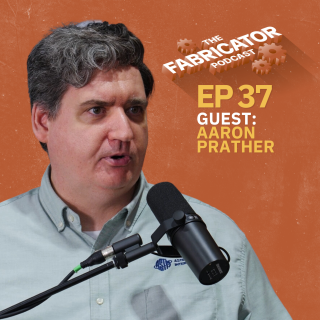The rapid pace of automation and robotics with Aaron Prather of ASTM
Aaron Prather, the director for the Robotics and Autonomous Systems Program at ASTM International, joins The Fabricator Podcast to talk about the importance of robotics and automation standards in manufacturing and the metal fabrication sector.
Prather emphasizes the need for input from small and medium-sized businesses in order to address their specific challenges and develop relevant standards. He also highlights the potential for Automation-as-a-Service and the importance of engaging young people in manufacturing through educational programs and facility visits. Additionally, Prather mentions his time working with FedEx, the involvement of ASTM in developing standards for the cannabis industry, and the future potential of robotics in industries such as hypersonic and space components.
At the top, the guys talk about their favorite movie and TV robot characters as well as Andy Kaufman's long-forgotten movie flop, Heartbeeps.
Email us at podcast@fmamfg.org with any comments, questions, or suggestions.
In This Episode
Learn more about the FMA's most recent industry surveys.
Learn more about the 2024 FMA Annual Meeting.
Check out ASTM International
Follow Aaron Prather on LinkedIn
ABOUT THE FABRICATOR PODCAST
The Fabricator Podcast brings you conversations with people in manufacturing who make things out of metal. We speak with manufacturers, metal fabricators, welders, job shop owners, small business entrepreneurs, artists, marketers, educators, and more. Host Dan Davis also goes beyond discussing just manufacturing and the skilled trades, and chats about pop culture, current events, food, music, movies, comedy, and, of course, robots. The Fabricator Podcast is presented by the Fabricators & Manufacturers Association.
Host: Dan Davis
Producer/Editor: Gareth Sleger
Video Producer/Editor: Brandon Geier
Ad writer/spokesperson/social media: Sara Spring
Additional video editing: Dana Wiker
Graphics: Billy Kulpa
Marketing support: Elizabeth Gavin, Mary Diamond
Sales support: Andy Flando, Amy Hudson
Web support: Mike Owens, Jared Carlow
Additional support: Ed Youdell, Maurine Semevolos, Lincoln Brunner, Tim Heston, Rafael Guerrero, Josh Welton, Darla Welton, Amanda Carlson-Hicks, Callie Check, Rick Lehnhardt, Judy Steinbach.
Where to listen to The Fabricator Podcast:
Follow The FABRICATOR:
- YouTube
TRANSCRIPT
Dan Davis: Because you got a whole generation of people growing up with that like that's second nature to them.
Aaron Prather: Oh, yeah.
Dan Davis: Because I was laughing at it earlier and being a curmudgeon about it, and then I'm realizing, like, "Wait." I'm like, "I'm old."
Lincoln Brunner: I hate to be the bearer of bad news.
Aaron Prather: I mean, don't worry about that. I mean, I got shown up by a 12-year-old on a UR program. Literally, she just took the template away from me and says, "No, you do this, this, this, this, this." I'm like, "Huh? Dang. I've been programming robots for longer than you've been alive."
Sara Spring: Now available from FMA are two comprehensive industry-related surveys for 2023. The Salary, Wage and Benefit Survey for intel to help company owners and HR managers, as well as the Financial Ratios and Operational Benchmarking Survey for crucial business performance data. Visit fmamfg.org to download both annual surveys.
Dan Davis: Welcome to The Fabricator Podcast where we have blown up letters on the screen so I can read them more easily. I'm joined by my co-host Lincoln Brunner.
Lincoln Brunner: How do?
Dan Davis: You might know him from The Fabricator and such titles as The Tube & Pipe Journal. Today our guest will be Aaron Prather, director for the Robotics and Autonomous Systems Program at ASTM International. We'll be chatting about his take on robotics and manufacturing as well as some of the stuff he saw at FABTECH. But I would like to invite you to enjoy a look at our new setting.
Gareth Sleger: Yeah.
Lincoln Brunner: It's beautiful.
Dan Davis: Thank you to all the people that help contribute to this, Wayfair.
Gareth Sleger: It's Wayfair and Easy Canvas, Easy Canvas.
Dan Davis: Because we printed off a bunch of...
Lincoln Brunner: The DiVito Brothers with the table.
Dan Davis: Yes. We should give a shout out to Rob and Anthony of iRcustom for this excellent table, which I will not put my feet on while you're watching.
Gareth Sleger: We'll talk to them in a later episode about the whole project behind that.
Dan Davis: Yes. A very enjoyable conversation...
Lincoln Brunner: Yeah, absolutely.
Dan Davis: ... as anytime they show up. So as we're about to embark on this conversation about robotics, we were wondering what everyone's favorite robot might be. And then we discovered Andy Kaufman made a movie called Heartbeeps.
Lincoln Brunner: Which has to probably be one of the worst movies ever since another movie was scrapped because that one was so bad.
Dan Davis: Did we get a Rotten Tomatoes score on this?
Gareth Sleger: That's a good question. It's from 1981.
Lincoln Brunner: Ooh.
Gareth Sleger: And it was so bad, so poorly received that they scrapped Andy Kaufman's movie about Tony Clifton.
Dan Davis: Oh.
Lincoln Brunner: His alter ego.
Dan Davis: He lost his movie deal.
Gareth Sleger: Yeah.
Dan Davis: Oh.
Lincoln Brunner: Man. Can you imagine? Well, that article Danny wrote was so bad, you can't write another one for a year.
Dan Davis: I've been told that before, but somehow I escaped those confines. Can you give me a rundown on what exact... Wow, that's a one-star rating.
Gareth Sleger: It almost doesn't exist.
Lincoln Brunner: Oh, my goodness.
Dan Davis: Wow.
Lincoln Brunner: Zero percent.
Dan Davis: Can you give me summary on the movie?
Gareth Sleger: While at a repair factory, Val, played by Andy Kaufman, a robot valet...
Lincoln Brunner: Oh.
Gareth Sleger: ... I can't even march through this right now, meets Aqua-
Dan Davis: Oh.
Gareth Sleger: ... played by Bernadette Peters, a fellow automation... I meant, sorry, automaton.
Lincoln Brunner: Automaton?
Dan Davis: Automaton.
Lincoln Brunner: Oh, okay.
Gareth Sleger: Yeah, I don't know why that word looks so weird. Who functions as a party hostess?
Lincoln Brunner: Oh.
Dan Davis: Hey, now.
Lincoln Brunner: Already bad.
Gareth Sleger: They discover that they're in love with each other and flee from their duties.
Lincoln Brunner: Ooh.
Gareth Sleger: They look to establish a home. Val and Aqua create their own mechanized child.
Dan Davis: Whoa. Do you think that's what destroyed the movie?
Gareth Sleger: Yeah, but their happiness is short-lived since the relentless enforcer robot has been programmed to apprehend them.
Lincoln Brunner: Yikes.
Dan Davis: Oops. It might be those-
Lincoln Brunner: This looked so good on the scripts.
Gareth Sleger: It's like a Romeo and Juliet.
Dan Davis: Oh, is it? Who is the relentless enforcer robot?
Gareth Sleger: I don't know. It's...
Dan Davis: We don't have a-
Gareth Sleger: It's Randy Quaid.
Dan Davis: Oh, really?
Lincoln Brunner: Ooh.
Gareth Sleger: That this tracks.
Dan Davis: Maybe that explains a lot.
Lincoln Brunner: I think that led to the demise of this film-
Dan Davis: Yes.
Lincoln Brunner: ... right there.
Dan Davis: Christopher Guest was also in the movie.
Gareth Sleger: Yeah.
Lincoln Brunner: He's great.
Gareth Sleger: That was, like you said, star-studded.
Dan Davis: None of us had heard of this, so I'm not going to pretend like-
Gareth Sleger: No.
Dan Davis: ... Mr. Heartbeep Val was one of the favorite robots of anyone in this room.
Lincoln Brunner: No.
Gareth Sleger: What really caught our eye was just-
Lincoln Brunner: Val doesn't make the cut.
Gareth Sleger: ... the costume.
Lincoln Brunner: However, K-2SO from Rogue One does make the cut. That is my favorite movie robot.
Dan Davis: Warm and fuzzy feeling?
Lincoln Brunner: Yes. Even though he was very tall and if-
Dan Davis: Oh.
Lincoln Brunner: ... [inaudible 00:04:56].
Dan Davis: I will add, just having spoken with a colleague, Tim Heston, who said his favorite robot was Robot from Lost in Space because they both have a tendency to flail their arms around when there's danger. That made me laugh.
Gareth Sleger: Tim does this?
Dan Davis: Tim did indicate that he may exhibit that...
Lincoln Brunner: Tendency?
Dan Davis: Yes. I agree. While I do not flail my arms, I also like Robot from Lost in Space because who doesn't want a robot buddy to get you out of trouble?
Lincoln Brunner: That's like-
Gareth Sleger: Yeah.
Lincoln Brunner: ... Danger Dan Davis.
Dan Davis: Yeah. You had mentioned your favorite sexy robot, Gareth?
Gareth Sleger: I'm not getting into it.
Dan Davis: I think you did.
Lincoln Brunner: We can't talk about that on the air.
Dan Davis: What's her name from Jetsons?
Gareth Sleger: Yeah, yeah.
Dan Davis: Rosey from the Jetsons, yeah.
Lincoln Brunner: We can't talk about that on the air.
Dan Davis: Seriously, the entire package.
Lincoln Brunner: Literally.
Gareth Sleger: Well...
Lincoln Brunner: Yeah.
Gareth Sleger: Great.
Dan Davis: With all this, I think we should go into a more serious discussion about robotics in manufacturing, specifically metal fabricating, and enjoy.
Sara Spring: Navigate your leadership journey at the FMA Annual Meeting, February 27th to the 29th, in Clearwater, Florida. At this premier event, you'll connect with top leaders in the fabrication industry to share ideas, collaborate to solve business challenges, and build strategic relationships. Chart your course for success in 2024 and beyond at the FMA Annual Meeting. Find all the details at fmamfg.org. And now, back to the episode.
Dan Davis: Today we're talking with Aaron. Aaron, thanks for joining us.
Aaron Prather: Thank you for having me.
Dan Davis: Yeah, Aaron is with ASTM. It's acronyms I have trouble with. ASTM International. Can you give us an idea, Aaron, your role there at ASTM and maybe what ASTM's involvement with the metal fabricating industry is?
Aaron Prather: Yeah, I mean, I am the director of Robotics and autonomous system programs at ASTM. I oversee the standards making, workforce development issues, and training, and even some R&D and market analysis.
Aaron Prather: I look at a bunch of different things when it comes to robotics and automation, and so when we look at the metal fabrication industry, we're not a big player. Our friends over at the American Welding Society are very much the big standards group for this industry, but that's not to say we're not involved. Being a 125-year-old organization, we're in a lot of different industries. Sometimes it's only in small ways, but sometimes it's in big ways as well.
Dan Davis: Right. Your involvement with automation and robotics makes a lot of sense, particularly here at this year's, and a couple of years previous FABTECHs as well. There's a lot of automation out there now.
Aaron Prather: Oh, yeah.
Dan Davis: I mean ASTMs involvement, I mean, it would be timely. Do you think it's at the right time? Or is the industry gotten out a little bit ahead, and ASTM is trying to make up for lost ground?
Aaron Prather: Well, I mean, to be honest, with all us standards development organizations, SDOs as we call ourselves, we're always behind.
Dan Davis: Okay.
Aaron Prather: We are always behind because-
Lincoln Brunner: How do you mean?
Aaron Prather: Well, I mean, technology is always going to move faster.
Lincoln Brunner: Sure.
Aaron Prather: That it is always going to move faster-
Lincoln Brunner: Yes.
Aaron Prather: ... and we're just not always going to know what's happening right away.
Lincoln Brunner: Sure.
Aaron Prather: Now, that being said, we are trying our best to be faster. And we are trying to put mechanisms into our processes of how we even create a standard so it can get to market faster. We are starting to see that. We are starting to average, from the moment a organization, a group of people or whoever brings us a problem that they say we need to create a standard around, taking that to ASTM committee to be listened to, assigned, and then put into a working item process, and then to standards publication, we're getting it down to almost a year.
Dan Davis: Okay.
Aaron Prather: I mean, it is speeding up. We actually are going to probably publish some standards this year that only took six months.
Dan Davis: Wow.
Lincoln Brunner: Wow.
Aaron Prather: It's just because we have dedicated experts who are volunteering their time to help bring these standards to market. That's the big win. When industry and standards organizations work together, it goes faster.
Dan Davis: Right.
Lincoln Brunner: Right.
Dan Davis: Awesome.
Lincoln Brunner: You were saying before that you've got a lot of need for people to come to you-
Aaron Prather: Yes.
Lincoln Brunner: ... with issues that they're encountering in the shop or the factory. I found that fascinating. Can you tell me a little bit more about your need for input from the field in order to do your job better?
Aaron Prather: Yeah. I mean, prior to joining ASTM, I actually worked for FedEx for over 25 years where I led the R&D and testing work before a piece of automation or a robot would go out into our operations. So I started getting exposed to standards really early on.
Aaron Prather: I would go to the meetings, and I would contribute, and I would talk about what is FedEx's needs in all this? It was always great because there'd be other companies in the room, and they would be bringing their issues. But there was one drawback, and I think this is very important for this audience, is it was the bigger players.
Lincoln Brunner: Ah.
Aaron Prather: It was the Fortune 500 companies. It was the government agencies. It was the regulatories. Not many small and medium guys were in the room. That's one thing I want change. That's why I like coming to these shows to listen to the small and medium guys of, what are their pain points? What are the things that they need fixed, but they just don't have time to, or the resources to work on standards directly, like FedEx, and GM, and all of those other companies?
Aaron Prather: But if they tell us what they're looking for, they have advocates, and I'm one of them. I will advocate for a small and medium enterprise who says, "This is a gap in the standards framework that we need addressed." I will do that.
Lincoln Brunner: Wow.
Dan Davis: Yeah. Can you describe to us the type of standards that ASTM is looking at right now or have recently released?
Aaron Prather: I mean, we're very focused on test and performance. Let's just take a mobile robot, because we've done a lot of work in mobile robots initially, of just can your mobile robot navigate a defined area, not run into the walls? If we put obstacles in its way, a chair, a ladder, will it detect those and avoid those? That's one kind of test that we provide.
Aaron Prather: And then the whole thing is is for a manufacturer, that's probably something you want to know before you buy a robot that's going to be moving through your factory, of can it actually detect certain things? Can it detect that pallet that someone just put on the floor? Or is it going to run it over just because it can't see it? By having that test, we can tell with confidence that robot will avoid that. So, don't worry about that as a risk because we've already proven in the lab that that robot can do that.
Lincoln Brunner: Oh.
Dan Davis: Before we went on the air, you made the point of just what the acronym stands for, American Society of-
Aaron Prather: American Society for Testing and Material.
Dan Davis: So, that's what the organization does.
Aaron Prather: That is what we do.
Dan Davis: Yeah. So, if somebody were to buy, say, a mobile robot, if they say, "Is this thing ASTM qualified certified?" What would be the phrase?
Aaron Prather: There's not really many of those. If anything, were more tied into a larger standard. A lot of folks will be told-
Dan Davis: Okay.
Aaron Prather: ... about ISO 10218 or R15.06, and our tests very much support those.
Dan Davis: I got you. Yeah.
Aaron Prather: The whole thing is if your robot goes through one of our tests, more than likely it's now in compliance with a bigger safety standard that OSHA or another regulatory agency wants you to be in compliance.
Dan Davis: Got you.
Aaron Prather: So, by passing this test, you might have already checked a box on a bigger standard. That means OSHA is going to be like, "Yep, you did your work."
Dan Davis: So, you're helping the OEMs verify that their machinery is safe and going to be-
Aaron Prather: Yes.
Dan Davis: ... safe to work around and stuff.
Aaron Prather: That is correct.
Dan Davis: Gotcha. You've had a chance to walk around.
Aaron Prather: Mm-hmm.
Dan Davis: I assume you've seen a lot of cobots.
Aaron Prather: Oh, yes.
Dan Davis: Anything strike your interest as you see all those cobots?
Aaron Prather: I mean, cobots are really a fascinating technology. When I was at FedEx, we would have them in our labs so we could prove some concepts. If we were doing package testing of, "Can we pick up this package type? Can we pick up this package type?" we would use a cobot in our lab so we could test that because we are working closely to the robot.
Aaron Prather: The issue is is you go to a FedEx operation today, you're not going to see cobots in our operations. You're going to see the high-industrial, high-speed robots because that's the speed we needed. Those are in applications where the people aren't around. I think that's my biggest concern with cobots is if you are doing metal work, and it's not a collaborative application because of what your unique situation is, do you really need a cobot or are you wasting money on all those-
Lincoln Brunner: Ah.
Aaron Prather: ... additional safety features for a collaborative application that you're just not going to use?
Aaron Prather: That's the biggest thing I worry about, especially for small and medium guys, because they're on a budget. Money's tight. They got to prove a good ROI. Don't waste an extra 20-$30,000 on a robotic arm if you're not going to use the collaborative features of it.
Dan Davis: Yeah.
Lincoln Brunner: Sure.
Dan Davis: I will say that I think there's some companies out there that, I don't want to say question, but are probably concerned of how a lot of these shops have put cobots in-
Aaron Prather: Yes.
Dan Davis: ... without really fully thinking about their impact around those that work around them.
Aaron Prather: Yeah. I mean, sadly, I've been in too many factories and shops where there's a cobot, and there's a cage around it. I'm like, "Oh, my god. Why do you have your UR caged?" And they're like, "Well, it's picking up a sharp piece of metal. And as it's moving it across to this area to put it down, if someone walks past it, that sharp piece of metal is going to cut them. So, we had to put a cage around it." And I'm like, "This is something you should have thought through in your setups."
Lincoln Brunner: It's awfully hard to make it collaborative if it's sitting behind bars or mesh.
Aaron Prather: It's just do your risk assessment. Really walk through, and then select the right robot for your use case.
Lincoln Brunner: That leads me to ask, what's the litmus test? What are some questions people should ask themselves when it comes to deciding what kind of automation to incorporate into their production line?
Aaron Prather: Yeah. I mean, this is where you really should work with an integrator.
Lincoln Brunner: Okay.
Aaron Prather: Especially an integrator that's in your industry is the best. Now, not everyone's going to have that option.
Lincoln Brunner: Sure.
Aaron Prather: But really you should have that walkthrough with your integrator of, "This is what I'm trying to solve. This is what I think I need, but I also have budgetary concerns." Have that honest conversation. Yes, it's hard sometimes to admit like, "Hey, I only have a X amount of money for this," even though that doesn't sound good. You think you might want this, but you're not sure. There are no wrong answers, okay. And great integrators, this is the value. This is the real value because they'll make sure you get a great start from the get-go, and they match the right technology to the right usage.
Lincoln Brunner: Right, that's the customization that they offer.
Aaron Prather: Yes.
Lincoln Brunner: As you're watching cobots and automation advance forward at such an amazing clip, what are some things that you're seeing that people ought to be coming to you for? And you're talking the problems that you're hoping that people will tell you about. What are some things that you know can help with?
Aaron Prather: Right now, one of the reasons I'm at FABTECH is because I want to hear some of these, because I'm still trying to find out what are some of the challenges when it comes to this kind of thing. We recently launched a whole grasping group because there's been incidences where people bought end effector graspings that can-
Lincoln Brunner: Sure.
Aaron Prather: ... crush a human hand, and they put it into a collaborative application.
Lincoln Brunner: Ooh.
Aaron Prather: The whole thing is now you've added risk to your application without knowing it because you just over-selected an end effector. So, we're doing some testing around that, so we can actually provide some of that finger-strength data back so customers can make a better selection of what type of end effector they want.
Lincoln Brunner: That's a good example.
Aaron Prather: We just fired up a thing with the legged robots because we're starting to see all these humanoid robots coming. I know this isn't for really this group, but they're like, "We're not going to get past regulators if we can't prove our humanoid robots don't fall over on people." So, we are starting to work on some tests for that.
Aaron Prather: So, within the metal forming industry, the fabrication industry, if people have questions or they have an issue of, "Do we need to have a standard around this process?" bring it to one of us SDOs, and we will definitely talk about it. And we'll figure out, A, is there a solution already out there that just we're not publicizing, or do we need to fire up a team of experts to really maybe build a standard around this problem, to solve everybody's problem? And that's what we ultimately want to do is solve as many people's problems as possible through this work.
Dan Davis: Yeah. It's funny you say the end effector is... I've been at this with this particular magazine for 20 years, never come up in a conversation. It makes total sense. But was this something that end effector manufacturers approached you with? Or did the organization see a headline and say, like, "We need to get involved"?
Aaron Prather: Well, there has been some headlines. There was the Russian child incident at a chess match where it was just a robot that just picked up chess pieces and placed. And now, the people were supposed to keep their hand away from the robot while they were picking their pieces and moving them. But this child put their hand on a chess piece that the robot was going for, the robot, just doing its job, thought it was grasping the chess piece, but it grasped the child's finger and crushed it.
Dan Davis: Oh, wow.
Lincoln Brunner: Eh.
Aaron Prather: And then when that story came out, we started getting stories from factories of, "Well, that happened to Joe."
Dan Davis: Well, isn't that fun?
Aaron Prather: "That happened to Sam."
Lincoln Brunner: Really?
Aaron Prather: It's like, "Okay, we have a problem, guys."
Lincoln Brunner: That's not the kind of pipeline you want. You want it to be proactive.
Aaron Prather: We want it proactive, exactly. The whole thing is I highly recommend folks, if they're starting to see an issue, and they heard it from somebody else that they're having the same issue, both of you should call one of us.
Lincoln Brunner: How do they get ahold of you? We'll repeat it at the end, but how do they get ahold of you?
Aaron Prather: I mean, ASTM's, astm.org is our website. There are links all over there that connect with any of us. So, even if you just don't know who to connect with, there is a info at ASTM, and they will send it to the right party within our organization.
Lincoln Brunner: Okay.
Dan Davis: This is a little... I don't know if it comes across as silly or not, but is it a large organization where there are laboratories where tests are done? And there's, not scientists, I don't know what the appropriate researchers, hired to do some of this stuff?
Aaron Prather: Yeah, I mean, we're a mixed bag. We are an international organization. That's why we added international to our name, even though Americans at the beginning. And we have offices across the globe. We just recently opened our new headquarters in Asia and Singapore.
Dan Davis: Oh, wow.
Aaron Prather: And we're about to open some more offices in other countries.
Aaron Prather: Some of our testing is internal, but we work with numerous other labs that have that capability, and we'll contract out that work with them, and we'll work with them. Most of all those labs actually have helped develop some of the standards themselves, through their own research. One of our strengths is we have a very strong pipeline of research to standards where we will run things through numerous paces with researchers, independent labs, and make sure we are actually developing a standard that is repeatable and works for everybody.
Lincoln Brunner: That's pretty tall.
Aaron Prather: It's a tall order sometimes, but we get it done.
Aaron Prather: It's a group effort. I think the last time I checked, ASTM has access to over 30,000 experts in you name it. For robotics, we have about 130 dedicated experts-
Dan Davis: Wow.
Aaron Prather: ... representing 12 countries. That they are our go-to people, and they are writing and working on standards all the time for us.
Dan Davis: Has that expanded in recent years?
Aaron Prather: Oh, yeah.
Dan Davis: Just to reflect the increased adoption of robotics?
Aaron Prather: Yeah. When I joined ASTM, the group was about 50 experts.
Dan Davis: Wow. Wow.
Aaron Prather: As we've expanded the scope of our reach into robotics [inaudible 00:22:11] system, we've added more experts.
Lincoln Brunner: Wow.
Aaron Prather: And I will continue to add experts as we continue to add... That's another part of my job is really to seek out, "Who are these brains that are out there that I can tap into?" It runs the gamut. I have everyone from MIT, Princeton, Oxford on our groups, all the way over to IBM and Disney, all the way down to a couple mom-and-pop shops that dedicate their... I can send them something to test, and it might take them a little longer than the big guys, but they'll do it because they want to see it successful too.
Dan Davis: Do you come across a level of sophistication at that level?
Aaron Prather: Oh, yeah.
Dan Davis: Yeah.
Aaron Prather: Oh, yeah. I mean, and that's another part of just some of the challenges of my job is sometimes it's like, "Do I need that MIT professor, or do I need the guy on the ground who really knows how the stuff is going to go down?" Quite frankly, I lean more towards that latter guy-
Lincoln Brunner: Sure.
Aaron Prather: ... because they know what's going on.
Lincoln Brunner: Well, they've already made the mistake. They've already seen how to do it wrong.
Aaron Prather: Yes.
Lincoln Brunner: Hopefully they haven't lost a finger in the process.
Dan Davis: Only in Indiana and Oklahoma. I don't know.
Lincoln Brunner: Wait. I'm curious of going back to your experience at FedEx and just geeking out in your lab. What are some ways of finding out problems that you discovered there? I mean, I-
Aaron Prather: Oh, wow. I think one that will probably be interesting for your audience, because I've actually seen some of the technology around here, is RFID.
Lincoln Brunner: Okay.
Aaron Prather: Of using RFID tags to identify a part as it's coming up the line-
Lincoln Brunner: Oh, sure.
Aaron Prather: ... to then tell the automation.
Lincoln Brunner: Sure.
Aaron Prather: FedEx was working on RFD way before that. Because think about RFID on every package. You don't got to scan anything anymore. But the issue with RFID is it doesn't go through certain metals. And water actually will mess up its signal.
Aaron Prather: Right before I left, I had one of the largest RFID testing arrays on the planet. I mean, it was over 100,000 square feet-
Lincoln Brunner: What?
Aaron Prather: ... of RFID arrays. I had every material in there. And RFID is really good until it's not. In a factory setting, I think there's a lot of applications. Especially if you're doing certain parts, and a part comes up. The RFID said, "Hey, for this part, I only need this, this, this done," and that's all the robots do. The next part comes up say, "Oh, I need this added on," and it does that. That is going to be a game changer for customized manufacturing.
Lincoln Brunner: Interesting.
Aaron Prather: But the issue for logistics is metal, water. As the package moves through a system, it's going to encounter a bunch of different things like that.
Lincoln Brunner: And say aluminum? I just-
Aaron Prather: Aluminum is the worst.
Lincoln Brunner: Yeah.
Aaron Prather: I mean-
Lincoln Brunner: I mean, I got a transponder in the mail the other day from the State of Illinois, because I live in Wisconsin, and it was wrapped in aluminum foil to keep, I don't know, signals out, keep it from getting messed up [inaudible 00:25:16].
Aaron Prather: Yeah, and the other thing that was big about RFD, especially for a FedEx or a UPS or a DHL, is if you have millions of those in one area, because that's where all the packages are-
Lincoln Brunner: Uh-oh.
Aaron Prather: ... how do you filter out the noise of not just all the packages, but something like what you just described being inside not being wrapped in aluminum. Because you're going to get that signal as well, so you got to filter that out.
Lincoln Brunner: Wow. Big challenge.
Aaron Prather: Yes.
Dan Davis: Yeah, I'm thinking about that big UPS hub near 294 in Chicago.
Aaron Prather: Yeah.
Lincoln Brunner: Yeah.
Aaron Prather: You should drive by it one day with an RFID reader, and just it'll go crazy.
Lincoln Brunner: Cheap entertainment.
Dan Davis: Yeah, there you go.
Lincoln Brunner: Yeah, that's really fascinating because as even smaller shops are looking for ways to automate, make things faster, all the way up to the really big boys, I mean, these kind of things will get in the way if they don't use them properly. That's where you guys come in, right?
Aaron Prather: Yeah. I mean, if anything, I welcome some of the small and medium shops. Just call us if you have a question.
Lincoln Brunner: Sure. Sure.
Aaron Prather: I mean, it might take a while to get to us as we're working on some other things, but I love... Just tell me your problems, and let's see what we can do for you.
Aaron Prather: I have pointed so many companies even on to ISO or ANSI or AWS because that's who has their solution they're looking for. ASTM has a system called Compass where we have nearly all the big other standards groups' standards on there. You can purchase them through Compass. Everyone gets their cut of money, but it's a one-stop shop. But if you just have a question, like, "I don't even know where to start," call us.
Lincoln Brunner: Sure.
Aaron Prather: We will walk you through. And if you don't pay ASTM a dollar, so be it. I don't care. I want to solve your problems. That's what we're ultimately... We are a nonprofit, okay.
Lincoln Brunner: Yeah.
Aaron Prather: But we do make money in numerous areas to keep us funded. So, don't think calling us is going to turn into a massive bill. It's not.
Lincoln Brunner: Okay.
Aaron Prather: Now we can work on some things to make it a bill, but-
Lincoln Brunner: Yeah, we can take it the...
Aaron Prather: ... the whole thing is if you just have a general question, and like Aaron, "Where do I start?" feel free to reach out to me. I will try my best to get you an answer.
Lincoln Brunner: Okay.
Dan Davis: As you walk the floor here, are there other things that make you realize ASTM maybe needs to be involved with? Or are there certain things already in the works that coincide with what's being shared out there at the FABTECH floor?
Aaron Prather: There's a couple things. Again, I think we have to be... As a fellow SDO, AWS, they are very much the lead group. The first thing is is if they're working on something already, we're not going to get in the way. If anything, we're going to ask, "How do we help you? How do we support you? What do you need from us?" And if they don't need anything from us, that's fine, but we let the initial ones always take the lead.
Aaron Prather: But I am getting intrigued by some of the technologies that are going to be more than maybe US-centric or North America-centric, of how do we help to ensure we have where some of these OEMs can sell their products anywhere on the planet? I think that's going to be a... might be the next thing we have to look at. I can't put my finger on an exact one, but as we talked about, the technology is growing so fast-
Lincoln Brunner: Yes. Yes.
Aaron Prather: ... and some of these startups. I mean, think about it, what, two, three years ago, Path Robotics was this little startup, and now they're this monster.
Lincoln Brunner: It's a big booth.
Aaron Prather: The good thing is is a lot of their technologies are already in very established standards paths, so them going global is not going to be hard. But what about the next guy? As we start getting into more technologies, are there certain things that an ASTM or an ISO needs to step up to ensure that that OEM can sell their product everywhere because it's standardized?
Lincoln Brunner: Okay.
Dan Davis: For the most part, do you feel like the robotics and automation folks have a general knowledge and respect to make sure their new product introductions, new ideas, get filtered through those channels?
Aaron Prather: They're doing a very good job. The good thing is is every robotic arm, from FANUC to Yaskawa to UR, are all involved in these. The newer guys that are coming to market are starting to see that. As I talked about, the humanoid robots that seem to be popping up left and right, they reached out to us right away, saying-
Lincoln Brunner: Wow.
Dan Davis: Wow.
Aaron Prather: ... "Hey, we need help," because they saw this ain't going to get anywhere unless they can refer back to a standard. And because humanoid robotics are so new when you really talk about real world applications, no one was working on those. So, we have definitely jumped in there, and we have the support of the other SDOs. Some SDOs are actually working on other components in that area. So, we are actually trying to speed up. We don't want to wait five, 10 years of, "Oh, now you need us." No, let's be proactive. Let's get going now, before it becomes a problem.
Dan Davis: Well, you mentioned the humanoid robots. I mean, it's not going to be five years. But, I mean, it was only three or four years ago when the cobots started making their debut, and now they're everywhere on the welding side.
Aaron Prather: Yep.
Lincoln Brunner: Now, and people-
Dan Davis: Also, kind of on the fab side.
Lincoln Brunner: Yeah. You can't go anywhere in this show floor without seeing somebody touting it as their major thing.
Dan Davis: Yeah.
Aaron Prather: Yeah.
Dan Davis: With your background from FedEx, looking at these different industries you get involved with, as you walk the floor at FABTECH, do you see something that may be applicable in those other industries-
Aaron Prather: Oh, yeah.
Dan Davis: ... that maybe makes sense here, that you don't really see-
Aaron Prather: Absolutely.
Dan Davis: ... on the show floor? What are some of those?
Aaron Prather: I mean, when mobile robots were starting to be explored by logistics companies, like FedEx and DHL and others, you know where we went first to look for, "Well, who's already doing mobile robots?" It was Ag.
Lincoln Brunner: It was NASA. Who?
Aaron Prather: Agriculture.
Lincoln Brunner: Oh, Ag? Oh.
Aaron Prather: So, a lot of the initial work was done through some of the Ag platforms. We reached out to a bunch of Ag schools, at FedEx, at Mississippi State, Kansas State, of like, "What are you guys working on when it comes to mobiles in Ag? Because it might have applications here."
Lincoln Brunner: Like mobile reapers and things like that?
Aaron Prather: Yeah.
Lincoln Brunner: Or what-
Aaron Prather: I mean, just how do they generally move through the field? How do they not run into things? Do they have to run into certain things? I mean, those were some questions. And it matured.
Aaron Prather: As I look through these, the first thing that comes to mind is, how far is welding away from packaging? Because you're welding and cutting to a specific thing and all that. In logistics, you want to make your boxes... You don't want... How many of us have had that Amazon box show up that's this big-
Lincoln Brunner: Yes.
Aaron Prather: ... and you open it up, and there's one little tiny thing?
Dan Davis: Right.
Lincoln Brunner: Right, right.
Aaron Prather: And Amazon is doing a great job there. They have some amazing technologies that they're working on packaging to right-size that. Some of those robots that are doing that are just freaking amazing. So, I see similarities between those Amazon robots that are right-sizing the packaging to the welding and cutting robots that are out here.
Lincoln Brunner: Oh, that are automatically identifying parameters and adjusting themselves? Yeah.
Aaron Prather: I'm wondering how far could some of these OEMs pivot their product and offer a packaging service to a smaller logistics firm, that's not Amazon, that doesn't have their own robotics group?
Lincoln Brunner: You see a direct one-to-one connection potentially.
Aaron Prather: Yeah. I mean, how different is it to make a custom metal part that fits in a very specific thing, different from making a very specific package type to go in a very specific thing.
Lincoln Brunner: That's a very good point.
Dan Davis: Never say never. I mean, that many of them have a lot of experience with packaging if they're doing really custom projects. Because they have to protect this as it's being shipped, and it's valued at X amount of dollars. And then the ying to that yang is probably the larger fabricators that are working with an OEM that require reusable shipping containers. I mean, they get pulled into it sometimes, whether they want to or not.
Aaron Prather: Yeah.
Dan Davis: Great.
Lincoln Brunner: Yeah.
Dan Davis: I mean, there's some amazing things. I mean, one of the things I'm looking at right now is where does robotics and automation fit into the manufacturing of hypersonic and space components? Because hypersonic and space components is going to be a big industry going forward. And when you have NASA asking those questions, like, "How are we going to do robots and automation to really mass produce these types of parts to go up into space?"
Lincoln Brunner: Somebody in this floor could probably lend a solution.
Aaron Prather: Oh, yeah. I've already talked to a couple of folks in this, and some of the feedback I've gotten is like, "We need help." I mean, there was one gentleman whose team is working on parts that go into satellites. And they're like, "There is no criteria to tell us what to build to...
Lincoln Brunner: Wow.
Aaron Prather: ... before we send this, and we know what's going into space."
Dan Davis: Wow.
Lincoln Brunner: Wow.
Aaron Prather: Going back to what we initially do is ASTM has a whole market research team. We're leveraging that group and myself to start asking these questions about, "Well, what's this going to look like, guys? How will this?" And talking to some of these folks on the floor today, a lot of them are saying there is a problem, but there is a solution, and it's collecting those. Again, exactly what we've been talking about.
Lincoln Brunner: But they need to talk to you.
Aaron Prather: Talk to us. Tell us.
Dan Davis: Tell us.
Lincoln Brunner: Yeah, call you. Well, and again, how can they best get ahold of you?
Aaron Prather: Yeah. I mean, I'm on LinkedIn. It's not hard to find. LinkedIn likes putting me at the top of the page. I do my best to respond to messages as quickly as I can. I get a lot of them, email. I'm pretty sure you guys will share my email address.
Lincoln Brunner: Yes.
Aaron Prather: It is just aprather@astm.org. Feel free to contact me there. And again, I will do my best to do it timely and quickly as possible. If I do need to hand you off to somebody else that does have that answer, I will do that so you can get that answer.
Lincoln Brunner: Very good.
Dan Davis: Before we go, I wanted to ask you about... You'd mentioned before what ASTM is involved with, and we were discussing about the cannabis industry.
Aaron Prather: Yes.
Dan Davis: Oh, thank goodness someone is actually gauging some of this effectiveness of what's available. But in terms, it's very important for some states that are not as open-minded as other states.
Lincoln Brunner: Yeah, or on the fence.
Dan Davis: Yeah.
Aaron Prather: Oh, yeah. I mean, ASTM, I mean, we're like ISO. We're in everything. I mean, we run the gamut from toy standards to robot standards, where I'm at, all the way up to cannabis standards now. Again, the cannabis industry came to us, saying, "We're not going to get anywhere with the FDA or state governments unless we show that we know what we're doing through standardization, through test methodologies that have been proven and backed up."
Aaron Prather: That actually happened right before the pandemic. We actually worked on those during the pandemic. I think we're up to almost about 14 published standards-
Dan Davis: Oh, wow.
Aaron Prather: ... and I know that they got more in the pipeline that they're working with. But it has actually helped convince certain states, namely Mississippi, to actually pass at least medicinal marijuana usage. But the whole thing is that just tells you the strength that a standard brings to an industry.
Lincoln Brunner: Well, but-
Aaron Prather: It shows that they know what they're doing.
Lincoln Brunner: To see your seal on something is like seeing the UL seal or something like that.
Aaron Prather: Oh, yeah.
Lincoln Brunner: They know that someone has looked at it. They know that someone has actually put scientific data into motion with this.
Aaron Prather: [inaudible 00:37:07].
Dan Davis: It keeps the government... I mean, it kind of allows the industry to evolve on its own and not wait.
Aaron Prather: Yeah, I mean, it all goes back to, I believe, a law that was passed back during the Clinton administration where organizations like OSHA and other regulatory agencies were pretty much told of lean on the standards organizations to develop standards and keep us out of it. And then we'll reference it.
Aaron Prather: But the whole thing is is they can bring enforcement to a standard if the industry has already agreed to that standard. So, OSHA can cite folks for not following best practices or certain standards. And the bad side to this, for us standards, just so everyone's aware of this, is the moment a standard is cited by the regulatory agencies, we have to put it out on our site for free.
Dan Davis: Oh.
Aaron Prather: So, we get no money on that.
Dan Davis: Oh.
Aaron Prather: This is why we do other things like market research and training and all that to keep us funded.
Aaron Prather: But we have over 13,000 standards on the books from ASTM, and I believe a little over 7,000 are enforced by somebody on this planet.
Dan Davis: Oh, wow.
Lincoln Brunner: Oh, if Bill had actually inhaled, maybe that all the cannabis standards would've had an easier time of getting passed.
Aaron Prather: But I do always joke of, you can play the game of go to your Home Depot, go to the Lowe's, walk the aisles, you will find an ASTM mark on one product in each aisle.
Lincoln Brunner: Sure. Absolutely.
Aaron Prather: Because we are everywhere.
Dan Davis: Yeah.
Lincoln Brunner: Oh, yeah.
Dan Davis: Power tools are a good thing to have standards for.
Lincoln Brunner: Oh.
Aaron Prather: Yes. Yes.
Lincoln Brunner: Phenomenally important.
Dan Davis: You got a question, Gareth?
Gareth Sleger: Yeah. I know your time at FABTECH has been limited because you were part of like two round tables, and we dragged you into this. And you've been here just one day, really.
Lincoln Brunner: Really? Yeah.
Gareth Sleger: Yeah. What's the most interesting thing you've seen on the floor, robotic-wise?
Aaron Prather: I would say some of these big machines that are over in Hall A have just been amazing. Because where else are you going to see those types of machines, unless you go to the factory? I mean, just seeing some of these machines manhandle what looks to be at least a 20-by-20 piece of metal, and folding it, and drilling holes in it all at once, that is amazing stuff.
Dan Davis: Yeah. And you mentioned the Path Robotics too.
Aaron Prather: And Path Robotics is amazing. Because, I mean, if you want to see the potential future of this industry, of what they're doing with robotics and AI and machine learning-
Dan Davis: And the vision technology.
Aaron Prather: ... and the vision, oh, my gosh. And I remember when they were just a little startup, and they were publishing research papers. And now they're this. I mean, that is amazing. It just makes you wonder who's the next one out here that is just going to take off?
Dan Davis: Yeah, the Path is something else where using that technology, they're just taking parts out based on CAD and vision. And the robot, I don't want to call it instinctively, but knows what to do in terms of welding. It's pretty awe-inspiring.
Lincoln Brunner: Well, you can see a lot of vision-based inspection guiding a lot of welding machines and things like that. I mean, that's what's happening now is real-time adjustment based on a machine's understanding through the lens of a camera.
Aaron Prather: Oh, yeah.
Lincoln Brunner: That is the inspection process.
Aaron Prather: Yeah, and actually that's one area that has been brought recently to us-
Lincoln Brunner: Really?
Aaron Prather: ... is, do we need to have some standardization around inspection robots?
Lincoln Brunner: Yeah. Well, they're everywhere now.
Aaron Prather: They're everywhere. I think, if anything, what we probably need to do in the coming months or years is maybe just, how do you do inspection robots? So, maybe not a standard, but maybe a guide. And ASTM has done that. We have done guidebooks.
Lincoln Brunner: Like a set of tutorials?
Aaron Prather: Yeah, that are just a tutorial that goes through of, "This is what you want to look for." On the additive manufacturing side, each year, we publish our Wohlers Report, which is a book that you probably could kill somebody with if you hit them hard enough.
Lincoln Brunner: Not that we would recommend that, but-
Aaron Prather: Yeah.
Dan Davis: A standard for God book.
Aaron Prather: But it spells out everything that's happened in additive manufacture the past year.
Lincoln Brunner: Yeah, wow.
Aaron Prather: What are the new parts that came? Who are the new players? Each year, that book just gets thicker and thicker because that's how much additive is growing.
Lincoln Brunner: Wow.
Aaron Prather: Our Wohlers team publishes that every year, and it sells really well. Folks just trying to figure out who are those players that are out there?
Gareth Sleger: And one thing, you mentioned Path, again, Tim Heston wrote an article recently, one of our editors, about when a welding robot has a brain. He wrote about a lot of these services have Automation as a Service now because the growth of automation is so quick that a lot of companies can't keep up. Are you seeing more and more companies offer that?
Aaron Prather: Yes. So Automation as a Service, Robots as a Service, I think that's actually going to be the future business model going forward, especially for the small and medium guys. It's just because you can control your cost. You pay a monthly fee. If the technology gets better and proves... Okay, it's like your iPhone. You just switch it out. You go trade in your old iPhone for the new one. You're still paying the... You might pay a little bit more, but the whole thing is is I think that's where we're going to. I mean, the iPhone model is probably the best way to think about this, is just you upgrade your robots or your automation.
Aaron Prather: Now, it will be interesting for the OEMs of how to figure out how that's going to work financially on their side, but I think it's the best way to get a smaller medium guy in it. Even for the larger guys, one things that those services provide is you don't need a CEO or a president and maybe not even a vice president sign-off because it's an expense now. It's just a monthly expense. It's not a capital.
Dan Davis: Yeah.
Lincoln Brunner: Right, right.
Dan Davis: They're doing that model with some of these cobots, where the little welding table and to let you get your feet wet, whatever it may be. And the other thing going is you got a whole generation of people growing up with that, like that's second nature to them.
Aaron Prather: Oh, yeah.
Dan Davis: Because I was laughing earlier in being a curmudgeon about it. Then I'm realize, like, "Wait." I'm like, "I'm old."
Lincoln Brunner: I hate to be the bearer of bad news.
Dan Davis: There you go. [inaudible 00:43:30] used to that.
Aaron Prather: Well, I mean, don't worry about that. I mean, I got shown up by a 12-year-old on a UR program. Literally, she just took the template away from me, says, "No, you do this, this, this, this, this." I'm like, "Oh. Dang. I've been programming robots for longer than you've been alive, and you just showed me up. Good play, kid." But that's where we're at.
Lincoln Brunner: Yes. Yes, we are.
Aaron Prather: I mean, and I'm hoping this is what helps the industry is I know the industry's trying to find workers. If we can show kids that this is the cool technology. These are not your grandfathers' factories.
Lincoln Brunner: No.
Aaron Prather: These are not those dirty factories-
Lincoln Brunner: It's being run by...
Aaron Prather: ... shown in your history textbook.
Lincoln Brunner: ... cobots.
Aaron Prather: I mean, I highly encourage every one of the attendees, the moment they leave here, go back and call their local schools and set up visits to their shop so kids can see what is really manufacturing now.
Dan Davis: Yeah, it's almost another case of searching. It's not just manufacturing companies searching for workers, but people finding manufacturing and knowing what's available.
Lincoln Brunner: That's almost like the technology finding people that can run it. I mean, it's a draw that not enough people know about.
Aaron Prather: Yeah. And I will give a plug to the ARM Institute in Pittsburgh. They launched roboticscareer.org to help address that. It's a great place to start. It's free. They don't charge. So even if you just want to go and just see what's out there, what training programs are out there, that's a great place to start. Again, it's free. And the ARM Institute in Pittsburgh who's tasked with that by the government, they launched it.
Dan Davis: Oh, yeah?
Aaron Prather: And it's a great little tool.
Dan Davis: Yeah. That's one thing our parent company, FMA, our foundation, nuts, bolts and thingamajigs, we run a series of manufacturing camps for kids. Most of those camps involve shops to manufacturing facilities, just to see that exact thing you're talking about.
Aaron Prather: Absolutely. I mean, I think that's the only way you're going to get them is kids need to see it. And when they do see it, man, their eyes get as big as everything. And I've seen kids move into manufacturing, and they all cite, "I saw this. I actually saw this, and I was like, 'I want to do that.'"
Dan Davis: Awesome. Well, thanks a lot, Aaron.
Aaron Prather: Yeah. Thank you for having me.
Dan Davis: [inaudible 00:45:53].
Lincoln Brunner: Fascinating. Fascinating. Thank you.
Dan Davis: Yeah. And if people want to reach you, you'd mentioned your email, aprather@astm.org.
Aaron Prather: .org, yep, and LinkedIn.
Dan Davis: Awesome. It's great that you have an easy email to remember because this is the biggest challenge of this podcast is when I try to remember ours.
Lincoln Brunner: You can do it.
Dan Davis: podcast@fmamfg.org.
Gareth Sleger: Yeah.
Dan Davis: Is that right?
Lincoln Brunner: Congratulations.
Gareth Sleger: Yeah, I always have to track it in my mind when you say it too, so you got it.
Dan Davis: Yeah, it's also like the eighth time I've done this at the FABTECH, so all right.
Lincoln Brunner: It's a good thing.
Gareth Sleger: Repetition does help.
Dan Davis: Yeah. Please rate, review, subscribe wherever you get your podcast, tell a friend. And anything else?
Gareth Sleger: Think that's good.
Dan Davis: All right, that's good. Thanks a lot for joining us. Until next time. Bye.
Lincoln Brunner: Thank you.
Sara Spring: The Fabricator podcast is a production of Fabricators and Manufacturers Association located in Elgin, Illinois. The show is hosted by Dan Davis and the staff of FMA Communications. The podcast is produced by Gareth Sleger and recorded and edited with the help of Brandon Geier. Sales support provided by Andy Flando. Additional production support by Elizabeth Gavin, Dana Wiker, Mary Diamond, Mike Owens, and me, Sara Spring. Thank you for listening.
Where to Listen

About This Podcast

All Episodes
-
 Ep. 053
Ep. 053 -
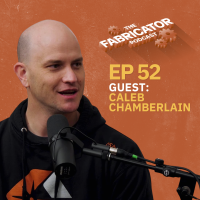 Ep. 052
Ep. 052 -
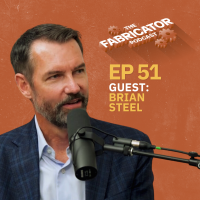 Ep. 051
Ep. 051 -
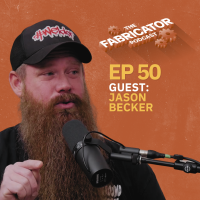 Ep. 050
Ep. 050 -
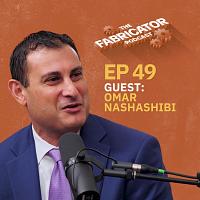 Ep. 049
Ep. 049 -
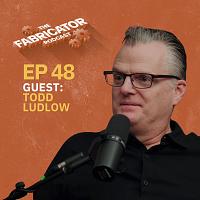 Ep. 048
Ep. 048 -
 Ep. 047
Ep. 047 -
 Bonus
Bonus -
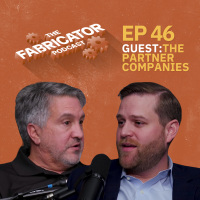 Ep. 046
Ep. 046 -
 Ep. 045
Ep. 045 -
 Ep. 044
Ep. 044 -
 Ep. 043
Ep. 043 -
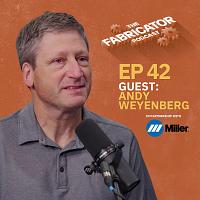 Ep. 042
Ep. 042 -
 Ep. 041
Ep. 041 -
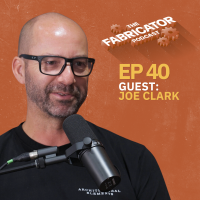 Ep. 040
Ep. 040 -
 Ep. 039
Ep. 039 -
 Ep. 038
Ep. 038 -
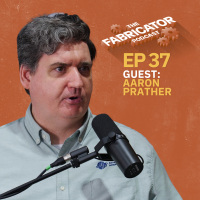 Ep. 037The rapid pace of automation and robotics with Aaron Prather of ASTM
Ep. 037The rapid pace of automation and robotics with Aaron Prather of ASTM -
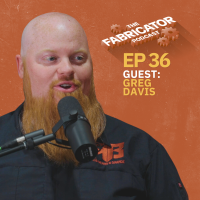 Ep. 036
Ep. 036 -
 Bonus
Bonus -
 Ep. 035
Ep. 035 -
 Ep. 034
Ep. 034 -
 Ep. 033
Ep. 033 -
 Ep. 032
Ep. 032 -
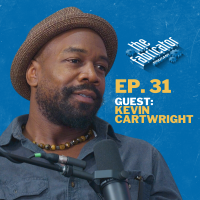 Ep. 031
Ep. 031
























